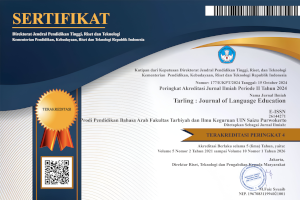Hipotesis Monitor Stephen Krashen dan Reorientasi Pembelajaran Istima-Kalam
DOI:
https://doi.org/10.24090/tarling.v5i2.5897Keywords:
Monitor Hypothesis, Learning Reorientation, Istima-Kalam learningAbstract
In this study, Author explains the monitor hypothesis of Stephen Krashen and Istima-Kalam Learning. With the hope of being able to provide solutions to the obstacles that have been experienced by Arabic language teachers and learners, especially when learning Istima-Kalam. The monitor hypothesis in istima-kalam learning must include instructions and correction procedures for each material learned and experienced by students. The correction process also needs to consider the smallest element of Arabic, namely harf. Students with difficulty pronouncing certain letters, must be given instructions or directions and monitored intensely. The instructions and corrections are needed to see to what extent the participants are able to master the correct pronunciation of letters, master the formation of words, and sentences according to tarakib in accordance with ‘ílm sharf (Arabic morphology) and ‘ilm nahw (Arabic syntax). Only then arrange connections and adjustments (muthabaqah) between sentences to become meaningful and acceptable oral or written.Downloads
Published
2022-01-10
Issue
Section
Articles
License
Authors who publish with this journal agree to the following terms:
- Authors retain copyright and grant the journal right of first publication with the work simultaneously licensed under a Creative Commons Attribution License that allows others to share the work with an acknowledgement of the work's authorship and initial publication in this journal.
- Authors are able to enter into separate, additional contractual arrangements for the non-exclusive distribution of the journal's published version of the work (e.g., post it to an institutional repository or publish it in a book), with an acknowledgement of its initial publication in this journal.
- Authors are permitted and encouraged to post their work online (e.g., in institutional repositories or on their website) prior to and during the submission process, as it can lead to productive exchanges, as well as earlier and greater citation of published work (See The Effect of Open Access).










